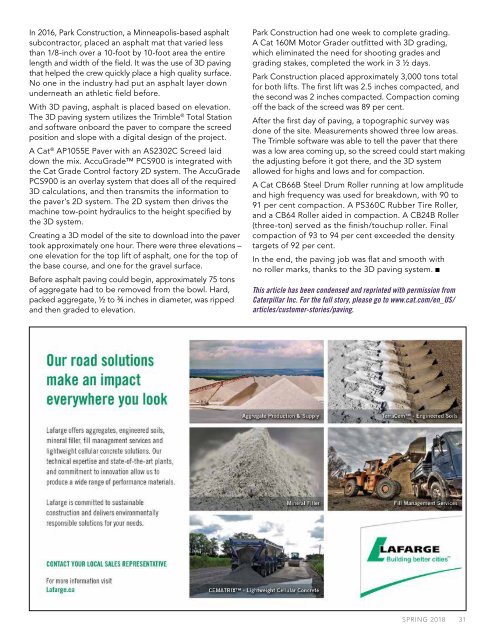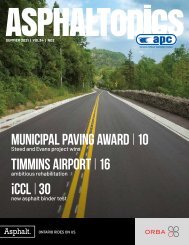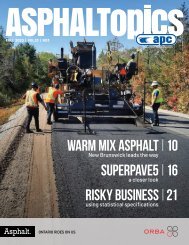ASPHALTopics | Spring 2018 | VOL 31 | NO 1
You also want an ePaper? Increase the reach of your titles
YUMPU automatically turns print PDFs into web optimized ePapers that Google loves.
In 2016, Park Construction, a Minneapolis-based asphalt<br />
subcontractor, placed an asphalt mat that varied less<br />
than 1/8-inch over a 10-foot by 10-foot area the entire<br />
length and width of the field. It was the use of 3D paving<br />
that helped the crew quickly place a high quality surface.<br />
No one in the industry had put an asphalt layer down<br />
underneath an athletic field before.<br />
With 3D paving, asphalt is placed based on elevation.<br />
The 3D paving system utilizes the Trimble ® Total Station<br />
and software onboard the paver to compare the screed<br />
position and slope with a digital design of the project.<br />
A Cat ® AP1055E Paver with an AS2302C Screed laid<br />
down the mix. AccuGrade PCS900 is integrated with<br />
the Cat Grade Control factory 2D system. The AccuGrade<br />
PCS900 is an overlay system that does all of the required<br />
3D calculations, and then transmits the information to<br />
the paver’s 2D system. The 2D system then drives the<br />
machine tow-point hydraulics to the height specified by<br />
the 3D system.<br />
Creating a 3D model of the site to download into the paver<br />
took approximately one hour. There were three elevations –<br />
one elevation for the top lift of asphalt, one for the top of<br />
the base course, and one for the gravel surface.<br />
Before asphalt paving could begin, approximately 75 tons<br />
of aggregate had to be removed from the bowl. Hard,<br />
packed aggregate, ½ to ¾ inches in diameter, was ripped<br />
and then graded to elevation.<br />
Park Construction had one week to complete grading.<br />
A Cat 160M Motor Grader outfitted with 3D grading,<br />
which eliminated the need for shooting grades and<br />
grading stakes, completed the work in 3 ½ days.<br />
Park Construction placed approximately 3,000 tons total<br />
for both lifts. The first lift was 2.5 inches compacted, and<br />
the second was 2 inches compacted. Compaction coming<br />
off the back of the screed was 89 per cent.<br />
After the first day of paving, a topographic survey was<br />
done of the site. Measurements showed three low areas.<br />
The Trimble software was able to tell the paver that there<br />
was a low area coming up, so the screed could start making<br />
the adjusting before it got there, and the 3D system<br />
allowed for highs and lows and for compaction.<br />
A Cat CB66B Steel Drum Roller running at low amplitude<br />
and high frequency was used for breakdown, with 90 to<br />
91 per cent compaction. A PS360C Rubber Tire Roller,<br />
and a CB64 Roller aided in compaction. A CB24B Roller<br />
(three-ton) served as the finish/touchup roller. Final<br />
compaction of 93 to 94 per cent exceeded the density<br />
targets of 92 per cent.<br />
In the end, the paving job was flat and smooth with<br />
no roller marks, thanks to the 3D paving system.<br />
This article has been condensed and reprinted with permission from<br />
Caterpillar Inc. For the full story, please go to www.cat.com/en_US/<br />
articles/customer-stories/paving.<br />
SPRING <strong>2018</strong> <strong>31</strong>

















